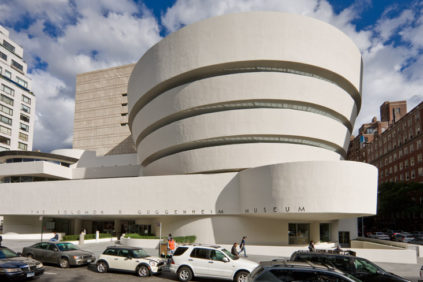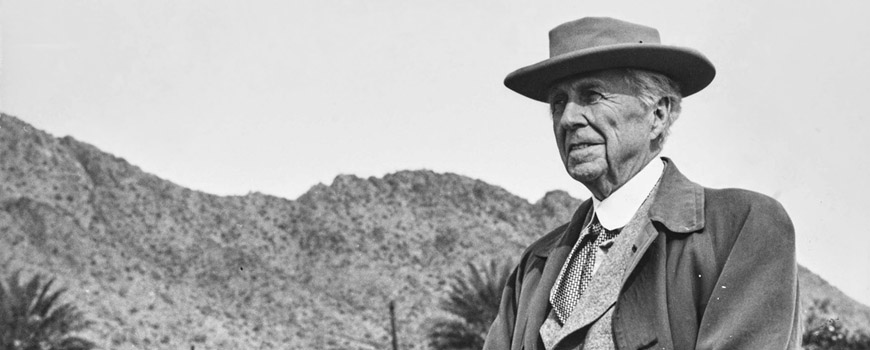Unknown photographer. Frank Lloyd Wright at Taliesin West, The Frank Lloyd Wright Foundation Archives (The Museum of Modern Art | Avery Architectural & Fine Arts Library, Columbia University, New York). Courtesy of The Museum of Modern Art, New York
Frank Lloyd Wright is arguably the most important American architect of all time, and the first “superstar” of modern architecture to become so famous to be portrayed, though quite fictionally, in a Hollywood film (The Fountainhead, 1949, starring Gary Cooper as a Wright-like strong-minded architect).
Wright’s life and professional career were possibly more astonishing than those of a fictional character. Born in Richland Center, Wisconsin, in 1867 to William Carey Wright, a preacher and musician, and Anna Lloyd Jones, a teacher of Welsh origins, in his childhood and early youth, Wright lived in a culturally stimulating, yet financially troubled, family.
Whether Wright ever graduated or not is a matter of debate, he attended for sure engineering and art courses at the University of Wisconsin but probably never got a degree; he did his architectural training by working for six years at the famous Adler & Sullivan firm in Chicago.
The Prairie Houses period and the worldwide success
After leaving Adler & Sullivan and opening his own office at 26, Wright started purchasing the creation of an “indigenous American architecture”, later called Prairie Style, inspired by the United States’ native culture and landscape. The Darwin D. Martin House Complex in Buffalo, NY, is possibly the best surviving example of this period.
Though Wright’s architecture of the time was eminently American, it was also open to external influences, particularly from the Japanese culture the architect admired throughout his life.
In the 1910s, Wright, now professionally world-renowned, was nevertheless unhappy with his personal life. After leaving his first wife Catherine with whom he had had six children, he started living with Martha “Mamah” Borthwick and moved from Chicago to a new home, named Taliesin, which he had designed and built at Spring Green, in his native Wisconsin.
The decline
Yet, in 1914, “Mamah” Borthwick, her two children (both adopted by Wright), and four other people were killed in Taliesin by a former employee, who also destroyed Wright’s estate by fire. From the early 1920s, the success of Wright started declining, mainly because both he (who was in his mid-fifties) as an architect and his Praire Style were considered outdated; furthermore, most of his few commissions went unbuilt.
Therefore, Wright began working – either by choice or necessity – more as a writer, a theorist, and a teacher than a professional architect; in 1932, he opened his architectural school in Taliesin, together with his new wife Olgivanna.
An unexpected comeback
In the 1930s, Wright’s professional career had an unexpected resurgence. This was, at least partly, due to a change in his architectural style. As in the case of his new Usonian homes, Wright’s architecture was simpler and clearer, the decoration was kept to a minimum while many technical innovations, such as passive heating and radiant floors, were introduced.
The integration with landscape was stronger than ever, at the point that, from a distance, some buildings – such as Wright’s new winter estate, Taliesin West, and the Kaufmann House (better known as Fallingwater) – seem more “densified” landscape than something built by human hands.
Then over 70 years old, in the 1940s Wright had more commissions than ever, a success that lasted until his death. Wright died in 1959 in New York, during the construction of his last masterpiece, the Solomon R. Guggenheim Museum.

Crystal Bridges Museum of American Art, Bentonville, AR

The Solomon R. Guggenheim Museum, an American revolution
copyright Inexhibit 2025 - ISSN: 2283-5474


